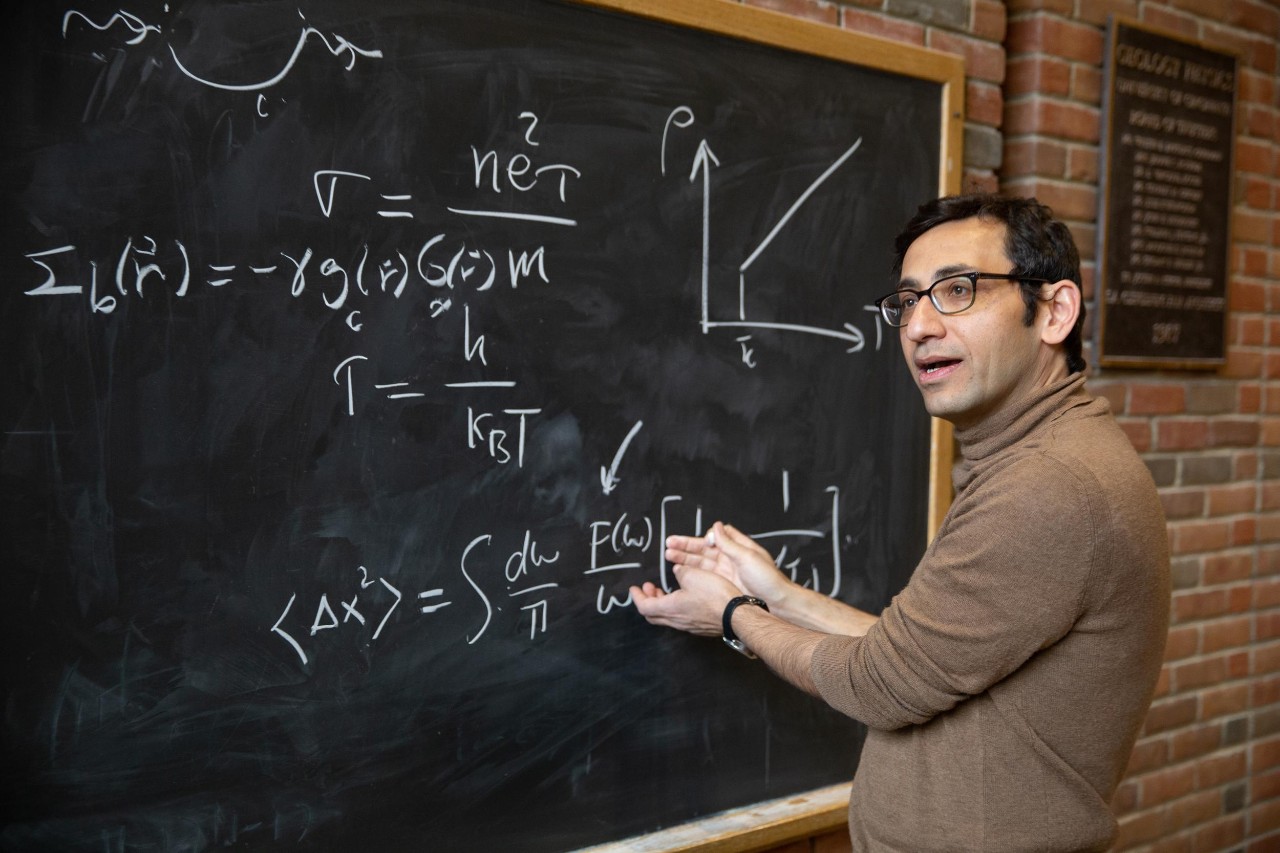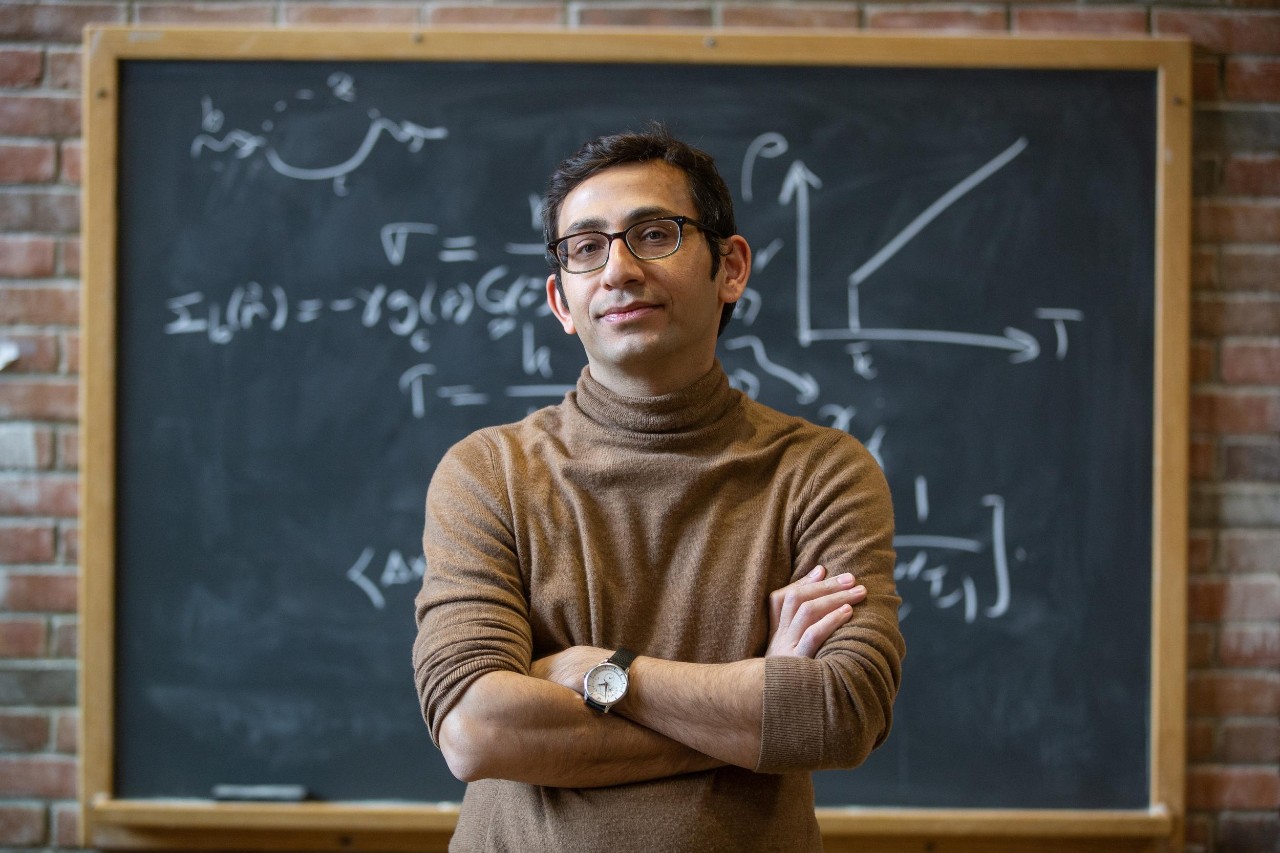
UC physicist explores mysteries of strange metals
International team finds unusual electrical behavior in experiments
Physicists at the University of Cincinnati are learning more about the bizarre behavior of “strange metals,” which operate outside the normal rules of electricity.
Theoretical physicist Yashar Komijani, an assistant professor in UC’s College of Arts and Sciences, contributed to an international experiment using a strange metal made from an alloy of ytterbium, a rare earth metal. Physicists in a lab in Hyogo, Japan, fired radioactive gamma rays at the strange metal to observe its unusual electrical behavior.
Led by Hisao Kobayashi with the University of Hyogo and RIKEN, the study was published in the journal Science. The experiment revealed unusual fluctuations in the strange metal’s electrical charge.
“The idea is that in a metal, you have a sea of electrons moving in the background on a lattice of ions,” Komijani said. “But a marvelous thing happens with quantum mechanics. You can forget about the complications of the lattice of ions. Instead, they behave as if they are in a vacuum.”

UC Assistant Professor Yashar Komijani worked with an international team of experimental and theoretical physicists to explore strange metals. Photo/Andrew Higley/UC Marketing + Brand
Komijani for years has been exploring the mysteries of strange metals in relation to quantum mechanics.
“You can put something in a black box and I can tell you a lot about what’s inside it without even looking at it just by measuring things like resistivity, heat capacity and conductivity,” he said.
“But when it comes to strange metals, I have no idea why they are showing the behavior they do. The mystery is why does the charge fluctuate so slowly in a strongly correlated quantum system?”
The mystery is why does the charge fluctuate so slowly in a strongly correlated quantum system?
Yashar Komijani, UC theoretical physicist
Strange metals are of interest to a wide range of physicists studying everything from particle physics to quantum mechanics. One reason is because of their oddly high conductivity, at least under extremely cold temperatures, which gives them potential as superconductors for quantum computing.
“The thing that is really exciting about these new results is that they provide a new insight into the inner machinery of the strange metal,” said study co-author Piers Coleman, a distinguished professor at Rutgers University.
“These metals provide the canvas for new forms of electronic matter — especially exotic and high temperature superconductivity,” he said.
Coleman said it’s too soon to speculate about what new technologies strange metals might inspire.
“It is said that after Michael Faraday discovered electromagnetism, the British Chancellor William Gladstone asked what it would be good for,” Coleman said. “Faraday answered that while he didn't know, he was sure that one day the government would tax it.”
Faraday’s discoveries opened a world of innovation.
“We feel a bit the same about the strange metal,” Coleman said. “Metals play such a central role today — copper, the archetypal conventional metal, is in all devices, all power lines, all around us.”
Coleman said strange metals one day could be just as ubiquitous in our technology.
“The big question about strange metals - is the origin of their scale invariance — their ‘quantum criticality,’” he said. “While the experimentalists are going to try to replicate our results on other strange metals, our team at UC and Rutgers will try to fold our new discovery into a new theory of the strange metals.”
The experiment was groundbreaking in part because of the way that researchers created the gamma particles using a particle accelerator called a synchrotron.
“In Japan, they use a synchrotron like they have at CERN [the European Organization for Nuclear Research] that accelerates a proton and smashes it into a wall and it emits a gamma ray,” Komijani said. “So they have an on-demand source of gamma rays without using radioactive material.”
Researchers used spectroscopy to study the effects of gamma rays on the strange metal.
Researchers also examined the speed of the metal’s electrical charge fluctuations, which take just a nanosecond — a billionth of a second. That might seem incredibly fast, Komijani said.
“However, in the quantum world, a nanosecond is an eternity,” he said. “For a long time we have been wondering why these fluctuations are actually so slow. We came up with a theory with collaborators that there might be vibrations of the lattice and indeed that was the case.”
The study was funded in part by the National Science Foundation and the Department of Energy.
Featured image at top: UC theoretical physicist Yashar Komijani is studying the properties of strange metals. Photo/Andrew Higley/UC Marketing + Brand
Next Lives Here
The University of Cincinnati is classified as a Research 1 institution by the Carnegie Commission and is ranked in the National Science Foundation's Top-35 public research universities. UC's graduate students and faculty investigate problems and innovate solutions with real-world impact. Next Lives Here.
Related Stories
Mural by UC grad honors U.S. military history
July 17, 2024
Local 12 highlighted a new mural by University of Cincinnati graduate and artist Brandon Hawkins that pays tribute to U.S. military history.
Social media fuels extreme political rhetoric
July 17, 2024
UC College of Arts and Sciences Professor Jeffrey Blevins tells Local 12 that online algorithms fuel political polarization on social media.
We love ‘Lucy’ — the AI avatar redefining UC tech transfer
July 17, 2024
In a visionary leap at the University of Cincinnati, the marriage of artificial intelligence and interactive technology has birthed "Lucy," a Smarthelp AI avatar poised to revolutionize how regional industries engage with UC's tech transfer initiatives.
NIS program opens new horizons for international student
July 17, 2024
In his pursuit of physics and a taste for research, Akash Khanikor ventured from his hometown in India's Assam to the University of Cincinnati, drawn by the promise of hands-on exploration early in his undergraduate career as a NEXT Innovation Scholar.
Camp aims to empower children, teens who stutter
July 17, 2024
A one-week, evidence-based program for children and teens who stutter at the University of Cincinnati will teach kids to communicate effectively, advocate for themselves and develop confidence about their communication abilities. Camp Dream. Speak. Live., which is coming to Cincinnati for the first time July 22-26, began in 2014 at the University of Texas at Austin. The Arthur M. Blank Center for Stuttering Education and Research at UT expects to serve more than 2,000 children at camps across the United States, Africa, Asia and Europe this year.
UC archivist explores Troy’s invisible workers
July 17, 2024
UC Classics archivist Jeff Kramer examined the unheralded and largely uncredited role laborers played in the 1930s excavation at Troy in Turkey.
U.S. stroke survival is improving, but race still plays role
July 16, 2024
U.S. News & World Report, HealthDay and Real Health covered new research from the University of Cincinnati that found overall rates of long-term survival following stroke are improving, but Black individuals experience worse long-term outcomes compared to white individuals.
Presidential challenge to UC: Join Ride Cincinnati to fight cancer
July 16, 2024
UC President Neville Pinto has again challenged every UC college and unit to send at least one rider to the September 14 Ride Cincinnati event to help fundraise for cancer research and cancer care. UC students ride free. Signup by July 31 for free UC-branded cycling jersey.
Building potential
July 16, 2024
Unexpected advice led to a new area of interest and growth for Andrew Matthews, leading him to the University of Cincinnati’s College of Engineering and Applied Science, construction management and cooperative education experiences at Turner Construction.
Pediatric ICU rates linked to housing quality, income, education
July 16, 2024
Healio highlighted research led by the University of Cincinnati and Cincinnati Children's Hospital's Carlie Myers that found a link between pediatric ICU admission rates and housing quality, household income and education.
